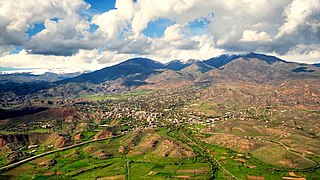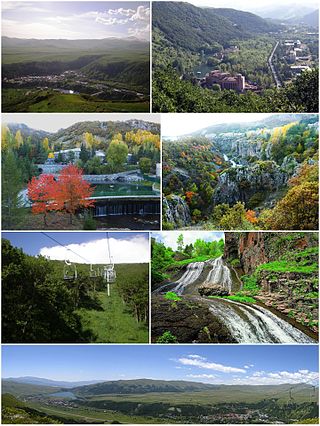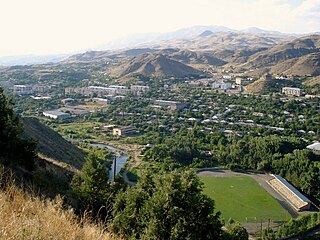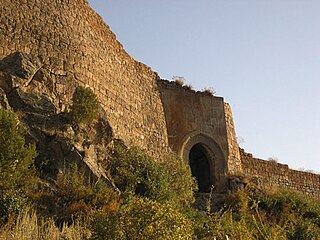
Vayots Dzor is a province (marz) of Armenia. It lies at the southeastern end of the country, bordering the Nakhchivan exclave of Azerbaijan to the west and the Kalbajar District of Azerbaijan to the east. It covers an area of 2,308 km2 (891 sq mi). With a population of only 52,324, it is the most sparsely populated province in the country. The capital and largest city of the province is the town of Yeghegnadzor.

Yeghegnadzor is a town and urban municipal community in southern Armenia, serving as the provincial capital of Vayots Dzor Province and the Yeghegnadzor Municipality. It is located at a road distance of 123 km (76 mi) south of the capital Yerevan, on the shores of Srkghonk River, at a height of 1,194 meters (3,917 ft) above sea level.

Jermuk is a mountain spa town and the centre of the Jermuk Municipality of the Vayots Dzor Province in southern Armenia, at a road distance of 53 km (33 mi) east of the provincial capital Yeghegnadzor. It was considered one of the popular destinations for medical tourism in the Soviet Union.

Noravank is a 13th-century Armenian monastery, located 122 km from Yerevan in a narrow gorge made by the Amaghu River, near the town of Yeghegnadzor in Armenia. The gorge is known for its tall, sheer, brick-red cliffs, directly across from the monastery. The monastery is best known for its two-storey Surb Astvatsatsin Church, which grants access to the second floor by way of a narrow stone-made staircase jutting out from the face of building.
Momik was an Armenian architect, sculptor and a master artist of Armenian illuminated manuscripts. As a sculptor, Momik is also known for his fine carving of khachkars, found primarily at the monastery complex at Noravank. He held an eminent position at the Gladzor School of Illuminated Manuscripts in Syunik, established at Vayots Dzor under the patronage of the Orbelian family's historian, Stepanos Orbelian. Of the manuscripts authored by Momik, only several survive: one is found at the repository of the Mekhitarist Order in Vienna and three others are found at the Mashtots Institute of Ancient Manuscripts in Yerevan, Armenia.

The Orbelian lords of the province of Syunik were a noble family of Armenia, with a long history of political influence documented in inscriptions throughout the provinces of Vayots Dzor and Syunik, and recorded by the family historian Bishop Stepanos in his 1297 History of Syunik.
Movses Kaghankatvatsi, or Movses Daskhurantsi, is the reputed author of a tenth-century Classical Armenian historical work on Caucasian Albania and the eastern provinces of Armenia, known as The History of the Country of Albania.

Vayk is a town and the centre of the Vayk Municipality of the Vayots Dzor Province of Armenia.

The Tatev Monastery is a 9th-century Armenian Apostolic Christian monastery located on a large basalt plateau near the village of Tatev in the Syunik Province in southeastern Armenia. The term "Tatev" usually refers to the monastery. The monastic ensemble stands on the edge of a deep gorge of the Vorotan River. Tatev is known as the bishopric seat of Syunik and played a significant role in the history of the region as a center of economic, political, spiritual and cultural activity.

Malishka is a village and rural municipal community of the Yeghegnadzor Municipality of the Vayots Dzor Province of Armenia.

Azatek is a village in the Vayk Municipality of the Vayots Dzor Province of Armenia, on the left bank of the Arpa River.

Hors is a village in the Yeghegis Municipality of the Vayots Dzor Province in Armenia. It is located 24 km northwest of the Province center, on the bank of the right-hand Hors tributary of Selimaget, 6–7 km northwest of the confluence of the Selimaget and Yeghegis rivers.

Yeghegis is a village in the Yeghegis Municipality of the Vayots Dzor Province in Armenia. It has a rich historical past, with the medieval Zorats Church, the Tsakhats Kar Monastery and the Smbataberd fortress being located in the vicinity of Yeghegis, as well as a Jewish cemetery from the 13th century.
Esayi Abu-Musa was an Armenian prince of southern Artsakh who ruled over a significant part of Arran in the mid-9th century and is considered the founder of the Principality of Dizak.

Surb Astvatsatsin of Areni is a single-nave two-aisled domed church completed in the year 1321. It is located atop a plateau overlooking the Arpa River and the village of Areni in the Vayots Dzor Province of Armenia.

Smbataberd is a medieval fortress located upon the crest of a hill between the villages of Artabuynk and Yeghegis in the Vayots Dzor Province of Armenia. It may have existed as early as the 5th century or earlier, although other sources date it to the 9th to 11th centuries. Its large basalt walls have been well preserved, but much less remains of the structures inside the fortress. It served as the main fortress of the Armenian princes of Syunik when Yeghegis was the seat of the rulers of that province. It was further expanded in the 13th century under the Orbelian dynasty. It is now a notable tourist site in Vayots Dzor.

Syunik was a region of historical Armenia and the ninth province of the Kingdom of Armenia from 189 BC until 428 AD. From the 7th to 9th centuries, it fell under Arab control. In 821, it formed two Armenian principalities: Kingdom of Syunik and principality of Khachen, which around the year 1000 was proclaimed the Kingdom of Artsakh, becoming one of the last medieval eastern Armenian kingdoms and principalities to maintain its autonomy following the Turkic invasions of the 11th to 14th centuries.

Diocese of Vayots Dzor, is one of the newest dioceses of the Armenian Apostolic Church covering the Vayots Dzor Province of Armenia. The diocesan headquarters are located in the town of Yeghegnadzor. The seat of the bishop is the 12th-century Holy Mother of God Cathedral of Yeghegnadzor.
The 735 Vayots Dzor Province earthquake affected the Vayots Dzor Province.
The 906 K'argop' earthquake took place in the monastery K'argop', Armenia, c. 906. The monastery was also known as Xotakerk', the monastery of the Vegetarians. The earthquake occurred approximately 150 years following the 735 Vayots Dzor Province earthquake, and affected the same region.














